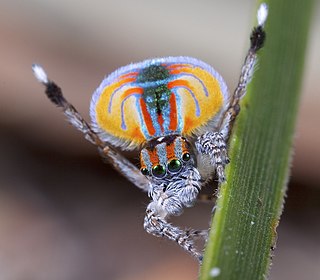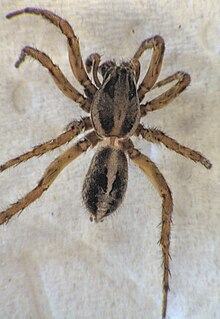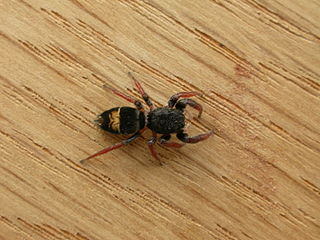
Jumping spiders are a group of spiders that constitute the family Salticidae. As of 2019, this family contained over 600 described genera and over 6,000 described species, making it the largest family of spiders at 13% of all species. Jumping spiders have some of the best vision among arthropods and use it in courtship, hunting, and navigation. Although they normally move unobtrusively and fairly slowly, most species are capable of very agile jumps, notably when hunting, but sometimes in response to sudden threats or crossing long gaps. Both their book lungs and tracheal system are well-developed, and they use both systems. Jumping spiders are generally recognized by their eye pattern. All jumping spiders have four pairs of eyes, with the anterior median pair being particularly large.

Maratus is a spider genus of the family Salticidae. These spiders are commonly referred to as peacock spiders due to the males' colorful and usually iridescent patterns on the upper surface of the abdomen often enhanced with lateral flaps or bristles, which they display during courtship. Females lack these bright colors, being cryptic in appearance. In at least one species, Maratus vespertilio, the expansion of the flaps also occurs during ritualised contests between males. The male display and courtship dance are complex, involving visual and vibratory signals.

Neon is a spider genus of the jumping spider family, Salticidae. Its described species occur mostly in Eurasia, with some species found in North and South America. One species, N. convolutus, is also found in Algeria. Two species are known from Australia, N. australis and N. taylori. N. australis has palp morphology and fringing on its first pair of legs very similar to that seen in N. nojimai Ikeda 1995, from Japan. N. taylori is most similar in morphology to N. sumatranus from Indonesia and N. kovblyuki from the Crimea and elsewhere. The genus is common and widespread in litter throughout Australia, from the highlands of Tasmania through the hot, dry inland to the wet tropics and includes many undescribed species.

Zenodorus is a genus of the jumping spiders distributed from the Moluccas to Australia, including several islands of the Pacific. It was once considered a junior synonym of Omoedus, but this was later rejected by Jerzy Prószyński in 2017. At least one species, Z. orbiculatus, specializes on hunting ants.

Servaea vestita is a species of jumping spider from Australia. It is found in Queensland, New South Wales and Tasmania.

Artoriopsis is a genus of wolf spiders first described by Volker W. Framenau in 2007. It is endemic to Australia and is most diverse in the southern half of the continent, though A. anacardium is found in the tropical north of Australia. Its body size ranges from 3 to 11 mm, with males smaller than females. It appears to prefer open, vegetated or sandy areas of moderate humidity.
Dolichoderus clarki is a species of ant in the genus Dolichoderus. Described by William Morton Wheeler in 1935, the species is found in wet sclerophyll areas of the central coast of New South Wales and the Australian Capital Territory. Workers of this species are known to forage on ground and on low vegetation.
Dolichoderus doriae is a species of ant in the genus Dolichoderus. It was described by Emery in 1887.
Dolichoderus etus is a species of ant in the genus Dolichoderus. Described by Shattuck and Marsden in 2013, the species is known from coastal New South Wales where it can be found in both wet and dry sclerophyll land, and they also nest in soil under rocks.
Ananeon is a monotypic genus of jumping spiders containing the single species, Ananeon howardensis. It was first described by B. J. Richardson in 2013, and is only found in the Northern Territory.
Frewena is a monotypic genus of jumping spiders containing the single species, Frewena maculata. It was first described by B. J. Richardson in 2013, and is only found in the Northern Territory.
Parahelpis is a genus of Australian jumping spiders that was first described by Joanna Gardzińska & Marek Michał Żabka in 2010. As of August 2019 it contains only two species, found only in New South Wales and Queensland: P. abnormis and P. smithae.
Ancepitilobus is a genus of spiders in the family Salticidae. It was first described in 2016 by Richardson. As of 2017, it contains only one species, Ancepitilobus howensis, found on Lord Howe Island. Its taxonomic relationships within the family are unknown.

Apricia is a genus of spiders in the jumping spider family Salticidae. It was first described in 2016 by Richardson. As of 2017, it contains 3 species, all from Australia.
Capeyorkia is a genus of spiders in the family Salticidae. It was first described in 2016 by Richardson. As of 2017, it contains only one species, Capeyorkia vulpecula, found in Queensland. Its taxonomic relationships within the family are unknown.
Pungalina is a genus of Australian jumping spiders that was first described by Barry J. Richardson in 2013.






